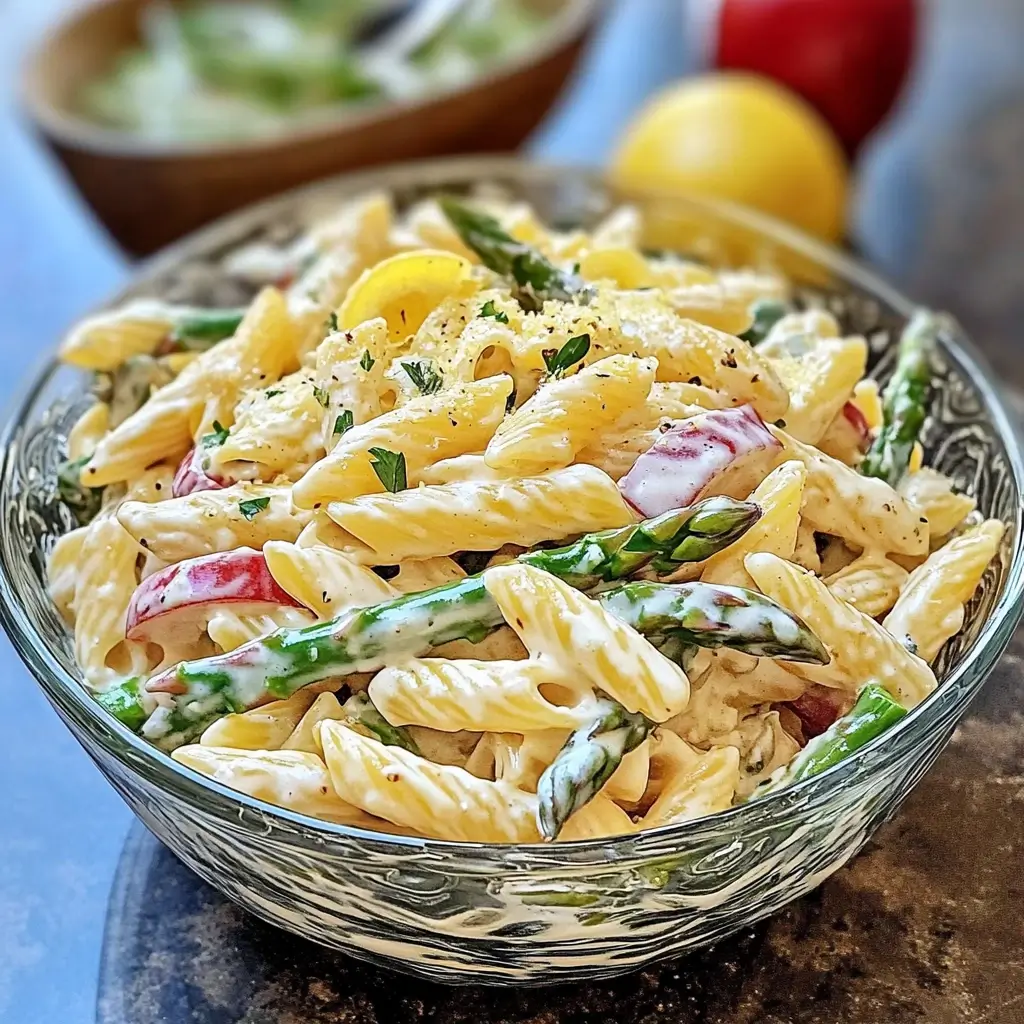There’s something undeniably uplifting about the arrival of spring. The days get longer, the air feels lighter, and fresh produce starts to pop up everywhere, bursting with vibrant colors and flavors. For me, spring isn’t just a season; it’s a culinary inspiration. And this Creamy Asparagus Pasta Salad? It’s the embodiment of spring on a plate.
I first stumbled upon this recipe while searching for a light yet satisfying side dish to complement our Easter ham. My family, while generally adventurous eaters, can be a tough crowd when it comes to anything too “healthy” sounding. Asparagus, bless its heart, sometimes falls into that category. But the description – “creamy,” “lemony,” “pasta salad” – piqued my interest. I decided to give it a try, hoping the creamy dressing and familiar pasta would win them over.
Let me tell you, it was an instant hit. From the first bite, the bright, zesty lemon dressing coated every strand of pasta and tender piece of asparagus, creating a symphony of flavors and textures. The creamy Greek yogurt base provided a satisfying richness without feeling heavy, while the fresh asparagus offered a delightful spring crunch. Even my notoriously vegetable-skeptical son devoured a generous helping, declaring it “actually really good!” That, my friends, is high praise indeed.
Since that first Easter dinner, this Creamy Asparagus Pasta Salad has become a staple in our spring and summer rotation. It’s incredibly versatile – perfect as a side for grilled chicken or fish, a delightful addition to a picnic basket, or even a light and satisfying lunch on its own. And the best part? It’s incredibly easy to make, requiring minimal prep time and readily available ingredients. If you’re looking for a recipe that’s both delicious and celebrates the fresh flavors of spring, look no further. This Creamy Asparagus Pasta Salad is guaranteed to become a new family favorite.
Ingredients: The Building Blocks of Spring Flavor
This recipe shines because of its simple yet flavorful ingredients. Each component plays a crucial role in creating the perfect balance of creamy, zesty, and fresh. Let’s break down what you’ll need for both the dressing and the pasta salad itself:
For the Creamy Lemon Dressing:
- 10 ounces Greek Yogurt: The star of our creamy dressing! Opt for plain Greek yogurt, and choose your fat percentage based on preference. Full-fat yogurt will yield the richest and creamiest dressing, while non-fat will be lighter and tangier. Greek yogurt provides a wonderful tang and body, far healthier than mayonnaise-based dressings, without sacrificing any creaminess. It’s also packed with protein, adding a nutritional boost to your salad.
- 4-5 tablespoons Freshly Squeezed Lemon Juice: Freshly squeezed lemon juice is absolutely key here. The bottled stuff simply doesn’t compare in terms of brightness and zing. The lemon juice provides the essential acidity that cuts through the richness of the yogurt and balances the flavors. Start with 4 tablespoons and add more to taste, depending on your love for lemon and the tartness of your lemons.
- 1 ½ teaspoons Minced Garlic: Garlic adds a subtle savory depth to the dressing. Freshly minced garlic is always best, but you can also use pre-minced garlic from a jar for convenience. Don’t be shy with the garlic; it complements the lemon beautifully and adds a delightful aromatic note.
- 4 tablespoons Olive Oil: Olive oil contributes richness and a smooth texture to the dressing. Extra virgin olive oil is recommended for its superior flavor and health benefits. It also helps to emulsify the dressing, bringing all the ingredients together in a harmonious blend.
- 1 tablespoon Honey: A touch of honey balances the tartness of the lemon juice and adds a subtle sweetness to the dressing. You can also use maple syrup or agave nectar as alternatives, but honey provides a lovely floral note that complements the lemon and asparagus particularly well. Adjust the amount of honey to your taste preference – if you prefer a tangier dressing, reduce the honey slightly.
- ½ teaspoon Lemon Pepper: Lemon pepper is a fantastic shortcut to amplify the lemon flavor. It provides both citrusy notes and a hint of peppery spice. If you don’t have lemon pepper on hand, you can substitute with freshly ground black pepper and a pinch of lemon zest.
- Zest from 1 Lemon: Lemon zest is where the real concentrated lemon flavor resides. It adds a bright, aromatic, and intensely citrusy element to the dressing that lemon juice alone can’t achieve. Be sure to zest only the yellow part of the lemon, avoiding the bitter white pith underneath.
- ½ teaspoon Sea Salt: Sea salt enhances all the flavors in the dressing and pasta salad. Use sea salt or kosher salt for the best flavor. Adjust the amount of salt to your taste, especially after you’ve combined all the dressing ingredients.
For the Pasta Salad:
- 1 pound Uncooked Pasta, such as Penne or Rotini: The type of pasta you choose will impact the overall texture and visual appeal of the salad. Penne and rotini are excellent choices because their shapes hold the creamy dressing well. Penne, with its cylindrical shape and angled cuts, offers a pleasant chewiness, while rotini, with its spirals, provides more surface area for the dressing to cling to. Other great options include fusilli, farfalle (bow tie pasta), or cavatappi. Feel free to experiment with your favorite short pasta shapes. For a gluten-free option, use your preferred gluten-free pasta.
- 1 pound Asparagus, ends trimmed and spears cut into 2-inch pieces: Fresh asparagus is the star vegetable of this salad, perfectly capturing the essence of spring. Look for firm, bright green asparagus spears with tightly closed tips. Snap off the tough woody ends of the asparagus – they naturally break where they become tender. Cutting the spears into 2-inch pieces ensures they cook evenly and are easy to eat in the salad.
- 1 cup Grape or Cherry Tomatoes, cut in half: Grape or cherry tomatoes add a burst of sweetness and juicy texture to the salad. Their vibrant red color also provides a beautiful visual contrast to the green asparagus and pasta. Halving them allows the juices to release and mingle with the dressing, adding another layer of flavor.
- ½ large Red Onion, thinly sliced: Red onion adds a pungent bite and a beautiful purple hue to the salad. Thinly slicing the red onion helps to mellow its sharpness and distribute its flavor evenly throughout the salad. If you find red onion too strong, you can soak the sliced onion in cold water for 10-15 minutes to reduce its intensity.
Instructions: Crafting Your Creamy Asparagus Pasta Salad Step-by-Step
Making this Creamy Asparagus Pasta Salad is surprisingly straightforward. It’s essentially a two-part process: creating the flavorful dressing and then cooking and assembling the salad. Here’s a detailed, step-by-step guide to ensure your success:
Part 1: Making the Creamy Lemon Dressing
- Gather Your Dressing Ingredients: Make sure you have all the ingredients for the dressing measured and ready to go. This will streamline the process and ensure you don’t miss anything.
- Combine Ingredients in a Jar: The easiest and most efficient way to make this dressing is in a jar with a tight-fitting lid. A mason jar or even a repurposed glass jar from store-bought sauces works perfectly. Add the Greek yogurt, freshly squeezed lemon juice, minced garlic, olive oil, honey, lemon pepper, lemon zest, and sea salt to the jar.
- Shake Vigorously: Securely screw the lid onto the jar. Now, shake the jar vigorously for about 30-60 seconds, or until all the ingredients are thoroughly combined and emulsified. You’ll notice the dressing becoming smooth and creamy as you shake. Shaking emulsifies the oil and yogurt, creating a cohesive and luscious dressing.
- Taste and Adjust: Open the jar and taste the dressing. This is your opportunity to customize it to your liking. If you prefer a tangier dressing, add a little more lemon juice. If you want it sweeter, add a touch more honey. If you like a bolder garlic flavor, add a pinch more minced garlic. Adjust the salt and lemon pepper to your taste as well. Remember, you can always add more, but you can’t take it away!
- Set Aside: Once you’re happy with the taste of the dressing, set it aside while you prepare the pasta and vegetables. The flavors will meld and develop as it sits. You can even make the dressing ahead of time and store it in the refrigerator for up to 3 days.
Part 2: Making the Pasta Salad
- Prepare the Pasta and Asparagus: Bring a large pot of salted water to a rolling boil. Salt the water generously – this seasons the pasta from the inside out. While the water is heating, trim the woody ends off your asparagus spears and cut them into 2-inch pieces. Halve your grape or cherry tomatoes and thinly slice the red onion. Having all your vegetables prepped and ready will make the cooking process seamless.
- Cook the Pasta: Once the water is boiling, add the pasta and cook according to package directions for al dente. Al dente pasta has a slight bite to it and holds its shape well in salads. Typically, this is around 10-12 minutes for penne or rotini. Set a timer to avoid overcooking.
- Add Asparagus to Boiling Water: In the last 2 minutes of the pasta cooking time, add the cut asparagus to the boiling water with the pasta. This ensures the asparagus is cooked tender-crisp – still slightly firm and vibrant green. Boiling the asparagus briefly with the pasta saves time and simplifies the cooking process.
- Drain and Rinse with Cold Water: Once the pasta and asparagus are cooked, immediately drain them in a colander. Then, rinse them thoroughly with cold water until they are completely cooled. Rinsing with cold water stops the cooking process, prevents the pasta from becoming mushy, and helps to cool down the vegetables quickly for the salad. Allow the pasta and asparagus to drain well to prevent watery salad.
- Combine Pasta, Asparagus, Tomatoes, and Onions: Transfer the cooled pasta and asparagus to a large mixing bowl. Gently stir in the halved grape or cherry tomatoes and thinly sliced red onion. Be careful not to overmix at this stage, as you don’t want to crush the tomatoes.
- Toss with Dressing: Pour the creamy lemon dressing over the pasta and vegetable mixture. Toss gently but thoroughly until everything is evenly coated with the dressing. You want every piece of pasta and vegetable to be kissed with that delicious lemon-yogurt goodness.
- Refrigerate to Chill: Cover the bowl tightly with plastic wrap or a lid. Refrigerate the pasta salad for at least 2 hours, or preferably overnight. Chilling allows the flavors to meld and deepen, and the pasta salad tastes even better after it has had time to rest in the refrigerator. The minimum chill time is crucial for the best flavor and texture.
- Serve and Enjoy: Before serving, give the pasta salad a gentle stir. You can serve it cold straight from the refrigerator, or let it sit at room temperature for about 15-20 minutes to take the chill off slightly if you prefer. Garnish with extra lemon zest or fresh herbs like parsley or dill, if desired. Enjoy your refreshing and flavorful Creamy Asparagus Pasta Salad!
Nutrition Facts: A Delicious and Wholesome Choice
This Creamy Asparagus Pasta Salad isn’t just delicious; it’s also a relatively healthy and nutritious option, especially compared to mayonnaise-laden pasta salads. Here’s an estimated nutritional breakdown per serving. Please note that these are estimates and can vary depending on specific ingredient brands and portion sizes.
Servings: 8-12 (depending on portion size as a side dish or main course)
Approximate Nutrition Facts per Serving (based on 10 servings):
- Calories: Approximately 350-400 calories
- Protein: 15-20 grams
- Fat: 15-20 grams (primarily from olive oil and Greek yogurt, including healthy fats)
- Saturated Fat: 3-5 grams (depending on the fat content of Greek yogurt)
- Cholesterol: 10-20 mg
- Sodium: 300-400 mg (can be adjusted based on salt added)
- Carbohydrates: 40-50 grams
- Fiber: 4-6 grams
- Sugar: 5-7 grams (primarily from honey and natural sugars in vegetables)
Key Nutritional Highlights:
- Good Source of Protein: Greek yogurt provides a significant amount of protein, making this salad more satisfying and helping to keep you feeling full.
- Healthy Fats: Olive oil contributes heart-healthy monounsaturated fats, and even the fat in Greek yogurt can be beneficial as part of a balanced diet.
- Fiber-Rich: Asparagus and whole wheat pasta (if used) are good sources of dietary fiber, which is important for digestion and overall health.
- Vitamins and Minerals: Asparagus is packed with vitamins K and folate, and tomatoes are rich in vitamin C and antioxidants. Greek yogurt provides calcium and probiotics.
- Lower in Unhealthy Fats and Calories than Traditional Pasta Salads: By using Greek yogurt instead of mayonnaise, this recipe significantly reduces the amount of unhealthy saturated fat and calories compared to traditional creamy pasta salads.
Important Note: These are estimations. For precise nutritional information, you can use online nutrition calculators and input the specific brands and quantities of ingredients you use. You can also adjust the recipe to further optimize its nutritional profile, such as using whole wheat pasta for increased fiber, reducing the amount of honey for lower sugar content, or using non-fat Greek yogurt for lower fat content.
Preparation Time: Quick and Easy from Start to Finish
One of the many things to love about this Creamy Asparagus Pasta Salad is its ease and speed of preparation. It’s a perfect recipe for busy weeknights or when you need to whip up a delicious side dish in a hurry.
- Prep Time: 10 minutes
- This includes washing and trimming the asparagus, halving the tomatoes, slicing the red onion, zesting and juicing the lemon, and measuring out the dressing ingredients. The dressing comes together in just minutes!
- Cook Time: 13 minutes
- This includes bringing the water to a boil and cooking the pasta and asparagus. The cooking time is relatively short, especially if you use quick-cooking pasta varieties.
- Minimum Chill Time: 2 hours
- While technically not “active” time, the chilling period is essential for the flavors to meld and the salad to reach its optimal taste and texture. However, you can prepare this salad ahead of time and let it chill overnight for even better flavor development.
- Total Time: 2 hours 23 minutes (including minimum chill time)
Time-Saving Tips:
- Pre-chop Vegetables: You can prep the asparagus, tomatoes, and red onion ahead of time (up to a day in advance) and store them in the refrigerator in airtight containers to save time on the day you plan to make the salad.
- Make Dressing in Advance: The creamy lemon dressing can be made up to 3 days in advance and stored in the refrigerator. This is a great way to break up the preparation and have the dressing ready to go whenever you need it.
- Utilize Pre-Minced Garlic: Using pre-minced garlic from a jar is a convenient shortcut that saves you a few minutes of prep time.
Overall, the active hands-on time for this recipe is minimal, making it a fantastic choice for those looking for a flavorful and healthy salad without spending hours in the kitchen. The majority of the total time is passive chilling time, which allows you to focus on other tasks while the salad becomes even more delicious.
How to Serve: Versatile and Delightful for Any Occasion
This Creamy Asparagus Pasta Salad is incredibly versatile and can be served in a multitude of ways, making it a go-to dish for various occasions.
- Side Dish Perfection:
- BBQs and Cookouts: It’s a refreshing and flavorful side dish that pairs beautifully with grilled meats like chicken, steak, burgers, or fish. It cuts through the richness of grilled foods and adds a bright, zesty element to the meal.
- Potlucks and Gatherings: Pasta salad is always a crowd-pleaser at potlucks. This creamy asparagus version is a step above the ordinary and is sure to be a hit. It travels well and can be made ahead of time.
- Holiday Meals: Perfect for spring holidays like Easter or Mother’s Day, as well as summer gatherings and picnics. It complements ham, roasted chicken, or other holiday main courses beautifully.
- Weeknight Dinners: An easy and delicious side to elevate simple weeknight meals. Pairs well with baked chicken, roasted salmon, or even vegetarian mains.
- Light Lunch or Main Course (with additions):
- Add Grilled Chicken or Shrimp: Transform this salad into a more substantial meal by adding grilled chicken breast, shrimp, or even chickpeas for a vegetarian protein boost. Grilled protein adds smoky flavor and heartiness.
- Tuna or Salmon Flakes: Flaked tuna or salmon are easy additions for a quick and protein-packed lunch.
- Hard-Boiled Eggs: Chopped hard-boiled eggs add protein and richness, turning the salad into a satisfying lunch option.
- Beans or Lentils: For a vegetarian or vegan main course, add canned cannellini beans, chickpeas, or cooked lentils for protein and fiber.
- Serving Temperature:
- Cold: The most common way to serve pasta salad is chilled, straight from the refrigerator. This is especially refreshing on hot days.
- Room Temperature: You can also let the salad sit at room temperature for about 15-20 minutes before serving to take the chill off slightly. Some people prefer the texture and flavor of pasta salad when it’s not ice-cold.
- Garnish Ideas:
- Fresh Lemon Zest: A sprinkle of fresh lemon zest on top just before serving enhances the lemon flavor and adds visual appeal.
- Fresh Herbs: Chopped fresh parsley, dill, or chives add a pop of color and fresh herbaceousness.
- Crumbled Feta Cheese: If you want to add a salty and tangy element, a sprinkle of crumbled feta cheese is a delicious addition (though not vegan).
- Toasted Pine Nuts or Almonds: For added crunch and nutty flavor, sprinkle toasted pine nuts or slivered almonds over the salad.
No matter how you choose to serve it, this Creamy Asparagus Pasta Salad is sure to be a delightful addition to your meal. Its versatility and fresh flavors make it a winner for any occasion.
Additional Tips for Pasta Salad Perfection
Want to take your Creamy Asparagus Pasta Salad to the next level? Here are five helpful tips to ensure pasta salad success every time:
- Don’t Overcook the Pasta: Al dente pasta is crucial for pasta salad. Overcooked pasta will become mushy and lose its texture when combined with the dressing and chilled. Cook the pasta just until it’s tender but still has a slight bite. Follow package directions and test for doneness a minute or two before the recommended time.
- Salt Your Pasta Water Generously: Salting the pasta water is essential for seasoning the pasta from the inside out. Use about 1-2 tablespoons of salt per gallon of water. This simple step makes a big difference in the overall flavor of your pasta salad.
- Don’t Skip the Cold Water Rinse: Rinsing the cooked pasta and asparagus with cold water is vital. It stops the cooking process, prevents the pasta from sticking together, and cools down the vegetables quickly, making them ready for the salad. This step also helps to maintain the bright green color of the asparagus.
- Taste and Adjust Seasoning: Always taste your dressing and the final pasta salad before serving. Seasoning is key to a flavorful dish. Adjust the lemon juice, honey, salt, and pepper to your liking. Remember, flavors can mellow slightly after chilling, so you might want to slightly over-season initially.
- Make it Ahead of Time (but not too far ahead): Pasta salad is often best made a few hours in advance or even the day before serving. This allows the flavors to meld and deepen. However, avoid making it too far in advance (more than 2 days), as the pasta can start to absorb too much dressing and become slightly soggy. If making ahead, you may need to add a tablespoon or two of olive oil or lemon juice just before serving to refresh the dressing.
FAQ: Your Creamy Asparagus Pasta Salad Questions Answered
Got questions about making this Creamy Asparagus Pasta Salad? Here are answers to some frequently asked questions to help you create the perfect salad:
Q1: Can I use mayonnaise instead of Greek yogurt in the dressing?
A: While you can substitute mayonnaise, the flavor and nutritional profile will be different. Greek yogurt provides a tangy creaminess that’s lighter and healthier than mayonnaise. Mayonnaise will result in a richer, heavier dressing with a different flavor profile. If using mayonnaise, you might want to reduce the amount of olive oil and lemon juice slightly, and you may not need to add honey at all, depending on the sweetness of your mayonnaise.
Q2: Can I make this pasta salad vegan?
A: Yes, you can easily make this pasta salad vegan! Simply substitute the Greek yogurt with a plant-based yogurt alternative. There are many excellent vegan yogurt options available made from soy, almond, cashew, or coconut. Choose a plain, unsweetened variety for the best results. The rest of the ingredients are already vegan-friendly.
Q3: Can I add other vegetables to this pasta salad?
A: Absolutely! This recipe is very adaptable. Other vegetables that would work well include:
- Bell peppers (diced): For added crunch and sweetness.
- Cucumbers (diced): For a refreshing and cool element.
- Snap peas or snow peas (halved or sliced): To enhance the spring vegetable theme.
- Sun-dried tomatoes (oil-packed, drained and chopped): For a more intense tomato flavor.
- Artichoke hearts (canned or marinated, quartered): To add a briny and slightly tangy flavor.
Feel free to experiment with your favorite vegetables to customize the salad to your taste.
Q4: How long does this pasta salad last in the refrigerator?
A: Properly stored in an airtight container in the refrigerator, this Creamy Asparagus Pasta Salad will last for 3-4 days. However, it’s best enjoyed within the first 2 days for optimal texture and flavor. After a few days, the pasta may start to soften slightly, and the dressing might become a bit thinner.
Q5: Can I freeze this pasta salad?
A: Freezing pasta salad is generally not recommended. Freezing and thawing can significantly alter the texture of both the pasta and the creamy dressing. The pasta can become mushy, and the dressing may separate or become watery. It’s best to make this pasta salad fresh and enjoy it within a few days. If you need to prepare ahead, make the dressing separately and cook the pasta and asparagus a day in advance, then assemble the salad closer to serving time.





